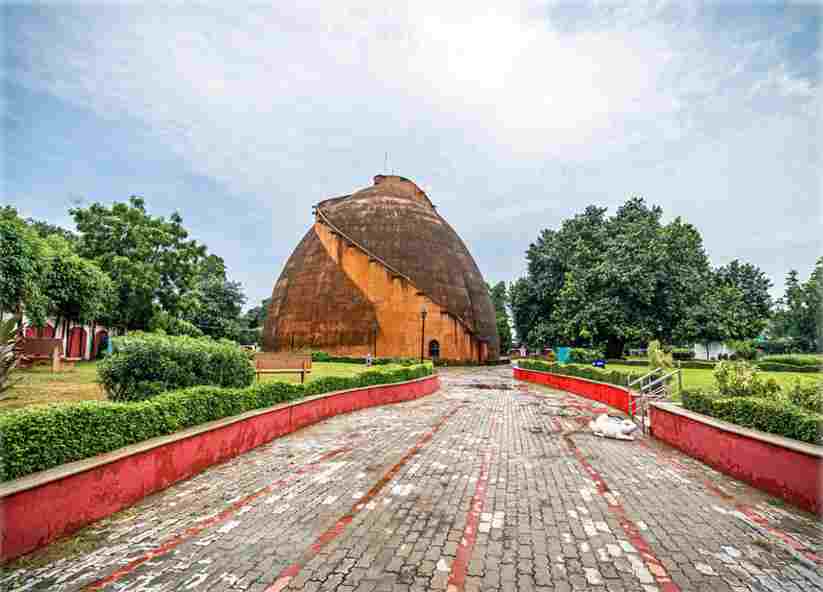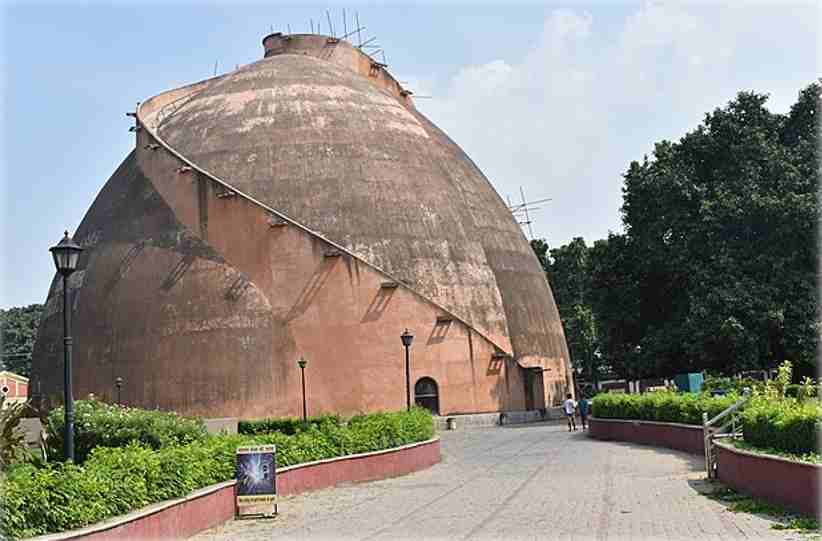- Umang Sagar
- 1 Comment
- Place, Recent article
The Golghar (Round House)

Introduction
- The Golghar, also known as the Round House, is a giant granary with a big dome, famous as Patna ka Ajuba. It is located west of Gandhi Maidan in Patna (Bihar’s capital), Bihar, India. It was once the tallest building in Patna, but people still see The Golghar surprisingly. At present, it is being used as a laser show theatre, and the government has made a park (a large green area) around it where people can enjoy and spend quality time with natural beauty. There is a small playground for kids and an old laser show spot where the laser show started for the first time on its campus. Around 200 people visit the Golghar daily. Visitors to the Golghar are not allowed to climb it because its stairs have become damaged over time. The Archeological Survey of India (ASI) began upkeep on February 26, 2011, and the monument was designated as one of Bihar’s protected heritages in 2017. The government established a laser show and an open-air theatre on the Golghar campus to depict the history of ancient Patliputra and the life of Gautam Buddha. People often compare it with the tomb of Md. Adil Shah (the Gol Gumbaz) situated at Bijapur (Vijayapura), Karnataka, India. It is said that the building was unsuitable for the purpose for which it was built because of an archaeological fault. The doors of the Golghar open inward, which is why they couldn’t be opened once they were filled with grains, whereas the visitors claim that they open outward. It is also said that the Golghar was never filled to its maximum capacity, but there is no evidence to prove this statement true. The structure is now more than 200 years old and has been designated as Bihar’s protected heritage. Scenes from The Golghar can also be seen in the Bollywood movie India’s Most Wanted. This historical monument is now being renovated.
History

- Those days, tax collection was done on a large scale by the East India Company, and local restrictions were imposed for goods going to Patna that resulted in a drought in 1769–1770 in which more than 10 million people died. After the terrible impact of the flood, John Shore (current president of the Council of Revenue) was sent to Patna by the East India Company to deal with the situation. John Shore proposed removing the local restrictions on goods going to Patna and constructing a massive granary to store massive amounts of grain for the British Indian Army in the Bengal region. And the East India Company’s Governor General, Warren Hastings, commissioned the architect Captain John Garstin of Bengal Engineers to design and build a massive granary to store massive amounts of grain. The construction of this building was started on January 20, 1784, and completed on June 20, 1786. It took 29 months to build this building. The Golghar was the first giant granary in the series of largest grain stores, according to inscriptions at its base.
Architecture

- The chief architect of this building was Captain John Garstin of the Bengal Engineers of the East India Company. It has a stupa-like structure, and there isn’t a single pillar in it. There are two sets of stairs to facilitate the work of the workers going to drop grains inside the Golghar through a 2-foot, 7-inch hole made on its top to drop grains inside it. Up to a height of 3 meters, the upper part of the building is made entirely of stones. The diameter of this building is about 32 to 36 meters, and its height is 129 meters from the ground. The wall thickness at its base is 3.6 meters, and there are 4 doors to get inside and come out of the building. It has two sets of 145 round stairs, one to climb up and one to return, that honor the work of the workers going to drop grains inside the Golghar.
Top 13 Interesting Facts About The Golghar
It has no pillars.
One sound echoes 27-32 times inside it.
It has 2 sets of 145 round stairs (one to climb up and one to return).
It was a giant granary made to store grains for The British Indian Army.
Once the tallest building in Patna.
It has never been filled to its maximum capacity.
It is declared one of Bihar’s protected heritage in the year 2017.
At present, it is getting used as a laser show theatre.
Around 200 people visit the Golghar daily but right now it is prohibited to climb it because of its damaged stairs.
It has the capacity to hold 14,00,000 metric tons of grains.
The Archeological Survey of India started its maintenance in the year 2011.
It took 29 months to complete the construction of this building.
The Golghar was the 1st giant granary in the series of biggest grain stores.





The article provides comprehensive and informative insights; looking forward to more of such valuable content.